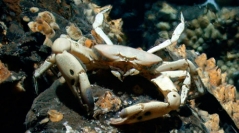

 Zoosystema
40 (5) - Pages 75-107
Zoosystema
40 (5) - Pages 75-107Two new species of the genus Austinograea Hessler & Martin, 1989 (Bythograeidae Williams, 1980), distinct from A. williamsi Hessler & Martin, 1989 and A. alayseae Guinot, 1990, are here reported from hydrothermal vent fields of the southwestern Pacific: A. hourdezi n. sp. and A. jolliveti n. sp., both in the Lau and North Fiji Back-Arc Basins. Austinograea hourdezi n. sp. is characterised by two depressions appearing as dark spots on the palm of both chelipeds in males and differs from the more northern A. williamsi and the Indian A. rodriguezensis Tsuchida & Hashimoto, 2002, which show only one spot on the male chelae, near the base of the dactylus. Some individuals exhibiting all morphological characters of A. hourdezi n. sp. bear only one spot on the chelae, near the base of dactylus; the fact that most are left-handed corresponds to the presence of a regenerated cheliped, with handedness reversal after the accidental loss of the major cheliped: these atypical individuals are here treated as A. hourdezi n. sp. The single spot that characterises each chela of A. jolliveti n. sp. is located at the base of the fixed finger in both sexes and shows as a differently pigmented, violaceous “pustule”, being similar to that of Bythograea microps Saint Laurent, 1984 from the East Pacific Rise. Moreover, A. jolliveti n. sp. can be distinguished by the shortest G2 found in Austinograea, especially by its reduced flagellum. A. hourdezi n. sp., represented by numerous specimens, was found to co-occur with A. alayseae in several vent sites of the Lau and North Fiji Back-Arc Basins, and both are probably distributed across a wide geographical range, whereas A. jolliveti n. sp., represented by only a few specimens, was collected from only two vent sites (ABE and Mussel Valley). In the northwestern Pacific, A. williamsi is apparently restricted to the Mariana Trough, where it is the only one member of the family Bythograeidae. The Manus Basin perhaps hosts an additional Austinograea species. In the western Pacific, vent fields are the only hydrothermal systems, except the East Pacific Ridge, that are not linearly distributed; different basins may host different species within the same brachyuran genus (five congeneric species of Austinograea, including A. rodriguezensis from the western Indian Ocean). The morphological distinction between the Austinograea species is supported by molecular analyses, for A. williamsi, A. alayseae, and A. hourdezi n. sp. A key to the five species of Austinograea is provided, in order to be able to potentially identify the crabs photographed in situ in their natural environment.
Gandalfus, hydrothermal site, western Pacific, Lau Back-Arc Basin, North Fiji Back-Arc Basin, Manus Basin, Mariana Trough, deep-sea fauna, new species